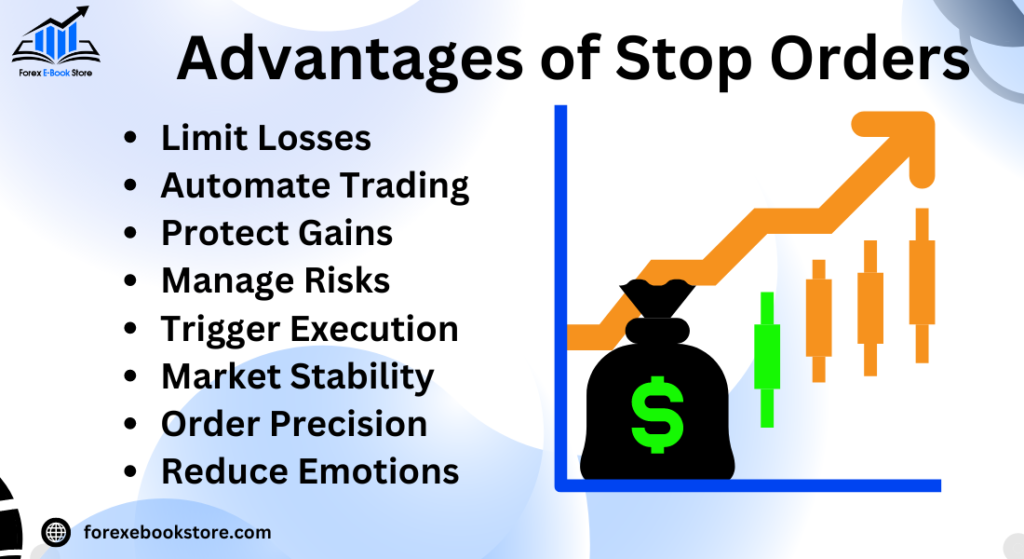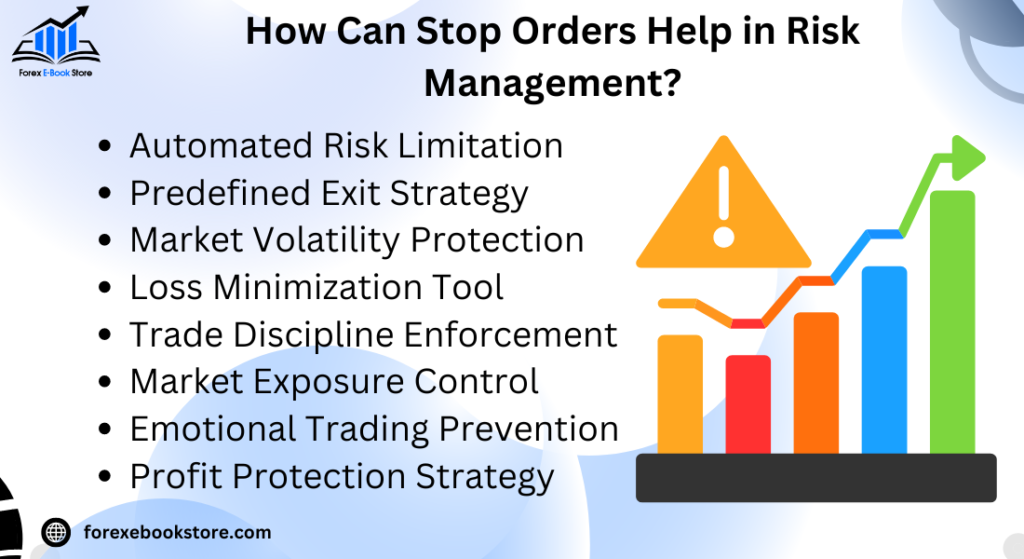A stop order is a type of trade order that investors use to buy or sell securities once the stock reaches a specific price, known as the stop price. This mechanism allows investors to protect their investments and manage risk by setting predetermined price points for buying or selling assets. When the stop price is reached, the stop order becomes a market order and is executed at the next available price.
Stop orders are commonly used in trading to limit potential losses or to enter a market when a stock’s price reaches a desired level. This tool is particularly useful for traders who cannot continuously monitor their investments, ensuring that they can automatically execute trades based on market movements. Understanding the various types of stop orders and their applications can significantly enhance an investor’s trading strategy.
Table of Contents
How Does a Stop Order Work?
A stop order functions as a safeguard for investors by automating the process of buying or selling securities when specific conditions are met. When an investor places a stop order, they set a stop price, which acts as a trigger. If the stock price reaches or falls below this stop price, the stop order is activated and becomes a market order, executed at the prevailing market price. This mechanism helps investors manage their investments without needing to monitor the market constantly.
For example, suppose an investor holds shares of Company A, currently trading at $50 per share. Concerned about potential losses, they set a stop order at $45. If the stock price declines to $45 or below, the stops order converts into a market order, and the shares are sold at the next available price. This strategy allows the investor to limit losses in a declining market scenario.
The effectiveness of a stop order depends on market liquidity and volatility. In highly volatile markets, the execution price may differ significantly from the stop price, potentially resulting in losses greater than anticipated. Therefore, investors should carefully consider market conditions and set stop prices accordingly to mitigate risks effectively.
What are the Different Types of Stop Orders?
There are several types of stop orders tailored to different trading strategies and market conditions:
- Stop-Loss Order: This is the most common type of stop order. Investors use stop-loss orders to limit losses by automatically selling a security when its price falls to a predetermined level.
- Stop-Entry Order: In contrast to a stop-loss order, a stop-entry order is used to buy a security once its price surpasses a specific threshold, enabling investors to enter a position as the price rises.
- Trailing Stop-Loss Order: This type of order adjusts the stop price dynamically as the market price moves in favor of the investor. If the stock price increases, the stop price moves upward accordingly, locking in profits or limiting losses.
Why Use a Stop Order?
The primary reason for using a stop order is risk management. By setting a predetermined exit or entry point, investors can protect their capital and minimize potential losses in volatile market conditions. These orders provide a level of automation, executing trades without constant monitoring, which is beneficial for busy investors or those unable to follow the market closely.
Moreover, stop orders help maintain discipline in trading strategies. They prevent emotional decision-making, such as holding onto a declining stock in the hope of recovery, by enforcing predetermined sell points. This discipline is crucial for long-term investment success, ensuring that losses are controlled and profits are protected.
What are the Advantages of Stop Orders?
Stop orders offer several advantages to investors seeking to manage risk and optimize their trading strategies:

One of the primary benefits of stop orders is risk management. By setting a stop price, investors can limit potential losses by automatically selling a security if its price falls below a certain level. This feature is particularly valuable in volatile markets where prices can fluctuate rapidly, ensuring that losses are contained and allowing investors to exit positions before further declines.
Another advantage is automation. Stops orders execute automatically once the stop price is reached, eliminating the need for constant monitoring. This automation is beneficial for busy investors who may not have the time to track market movements continuously. It ensures timely execution of trades based on predefined criteria, enhancing efficiency and reducing emotional decision-making.
Additionally, they help maintain discipline in trading strategies. They enforce predefined exit points, preventing investors from holding onto losing positions in the hope of a recovery. This disciplined approach ensures that investment decisions are based on objective criteria rather than emotions, which is crucial for long-term success in trading.
In summary, the advantages of these orders include effective risk management, automation of trade execution, and maintenance of disciplined trading strategies. These benefits make these orders a valuable tool for investors looking to safeguard their investments and optimize their trading activities.
What are the Disadvantages of Stop Orders?
While stop orders offer significant advantages, they also come with certain drawbacks that investors should consider:
One notable disadvantage is execution risk. In fast-moving markets or during periods of low liquidity, the execution price of this order may differ significantly from the stop price. This slippage can result in losses greater than anticipated, especially if the market experiences sharp fluctuations.
Another drawback is whipsawing. This occurs when a stop order is triggered by short-term price movements that do not reflect the long-term trend of the security. Investors may find themselves buying or selling at unfavorable prices if the market quickly reverses direction after triggering the it.
Additionally, stop orders can lead to missed opportunities. If it is triggered during a temporary price decline, investors may sell their positions prematurely, missing out on potential price recoveries. This can be particularly problematic for long-term investors who seek to capitalize on market fluctuations rather than react to short-term volatility.
Despite these disadvantages, many investors continue to use stop orders as part of their risk management and trading strategies. To mitigate the risks associated with these orders, investors should carefully assess market conditions, set appropriate stop prices, and consider alternative strategies such as trailing these orders in dynamic market environments.
How to Place a Stop Order?
Placing a stop order involves several straightforward steps to ensure proper execution and effectiveness:
- Choose the Right Brokerage Platform: Select a brokerage platform that supports stop orders and offers reliable trade execution services. Ensure that the platform provides clear guidelines on placing and managing these orders.
- Identify the Security and Quantity: Determine which security you want to trade and the quantity of shares or units you wish to buy or sell.
- Set the Stop Price: Define the stop price at which you want the stops order to be triggered. This price should reflect your risk tolerance and trading strategy, considering factors such as recent price trends and market volatility.
- Select the Type of Stop Order: Decide on the type of this order that best suits your investment goals, whether it’s a stop-loss order to limit losses or a stop-entry order to enter a position at a favourable price.
- Monitor Market Conditions: Regularly monitor market conditions and adjust your stop price if necessary. Market fluctuations and news events can impact stock prices, requiring proactive management of stop orders to optimize outcomes.
- Review and Confirm: Double-check all details, including the security, quantity, stop price, and order type, before submitting it. Confirm the order through the brokerage platform to initiate the trade.
What are the Common Strategies for Using Stop Orders?
Investors employ various strategies to optimize the use of stop orders in their trading activities:
One common strategy is stop-loss placement. Investors typically place stop-loss orders slightly below significant support levels or moving averages. This strategy aims to protect gains and limit losses by automatically selling a security if its price falls below a critical level. By setting stop-loss orders strategically, investors can mitigate downside risk while allowing their investments to benefit from potential upside movements.
Another effective strategy is trailing stop orders. Unlike traditional them, trailing these orders adjust dynamically with the market price. If the market price moves favourably, the stop price trails behind, maintaining a predetermined distance. This strategy enables investors to lock in profits as the stock price rises while protecting against sudden reversals by automatically selling if the price falls by a specified percentage or amount.
Additionally, breakout trading strategies often incorporate stops orders. Traders use stop-entry orders to enter positions once a stock’s price breaks out above a resistance level or a predefined range. This approach allows investors to capitalize on upward momentum while minimizing the risk of buying at inflated prices during volatile market conditions.
By implementing these and other strategic approaches, investors can leverage these orders effectively to enhance trading outcomes, manage risk, and align their investment strategies with market trends.
How Do Stop Orders Differ from Limit Orders?
Stop orders and limit orders serve distinct purposes in trading:

Stop orders become market orders once a specified price level is reached. They are typically used to manage risk by automatically executing trades to limit losses or enter positions at favorable prices. These orders are triggered by market movements and are executed at the best available price after the stop price is reached.
In contrast, limit orders allow investors to specify the maximum price they are willing to pay when buying or the minimum price they are willing to accept when selling. These orders are not executed immediately and remain active until the specified price level is met or exceeded. Limit orders provide more control over trade execution but may not guarantee execution if market conditions do not reach the specified price.
Understanding the differences between stop orders and limit orders is essential for investors to choose the appropriate order type based on their trading objectives, risk tolerance, and market conditions.
What are Stop-Limit Orders and How Do They Work?
Stop-limit orders combine features of stop orders and limit orders to provide additional control over trade execution:
A stop-limit order includes two price points: the stop price and the limit price. When the stop price is reached, the order becomes a limit order rather than a market order. The trade will only be executed at the limit price or better, ensuring that the investor does not receive an unfavorable price. This order type is beneficial in volatile markets where price fluctuations can be significant between the stop and execution.
For example, suppose an investor holds shares of Company B, currently trading at $100 per share, and sets a stop-limit order with a stop price of $95 and a limit price of $90. If the stock price drops to $95, the stop-limit order is activated, and a sell limit order at $90 is placed. The order will only execute at $90 or above, providing a price floor below which the investor is unwilling to sell.
Stop-limit orders offer precision in trade execution but may risk non-execution if the market quickly moves through the limit price. Investors should carefully consider market conditions and price volatility when using stop-limit orders to optimize their trading strategies effectively.
When Should You Use a Stop Order?
Knowing when to use a stop order is crucial for maximizing its effectiveness in trading strategies:
- Risk Management: Use stop orders to manage risk by setting predefined exit points. This is particularly important when holding volatile stocks or during uncertain market conditions. By implementing stop-loss orders, investors can limit potential losses and protect their capital against adverse price movements.
- Capital Protection: Employ stop orders to safeguard profits and protect capital gains. For example, if a stock has appreciated significantly, setting a trailing it can lock in profits as the stock price rises. This strategy allows investors to capture gains while ensuring that they do not lose accumulated profits in case of a market downturn.
- Trading Discipline: Utilize stop orders to maintain discipline in trading strategies. They prevent emotional decision-making by enforcing exit or entry points based on objective criteria rather than market fluctuations or investor sentiment. This disciplined approach helps investors adhere to their trading plans and long-term investment goals.
Determining when to use a stop order involves assessing individual risk tolerance, market volatility, and investment objectives. By incorporating these orders into trading strategies, investors can enhance risk management, protect capital, and maintain strategic discipline.
What are the Risks Associated with Stop Orders?
While stop orders offer benefits, they also carry inherent risks that investors should consider:
- Execution Risk: In fast-moving markets or low liquidity conditions, stop orders may execute at prices significantly different from the stop price. This slippage can result in losses greater than anticipated, especially during market volatility or rapid price fluctuations.
- Whipsaw Effect: The whipsaw effect occurs when a stop order is triggered by short-term price movements that do not reflect the long-term trend of the security. Investors may experience buying or selling at unfavorable prices if the market quickly reverses direction after triggering it.
- Market Volatility: Stop orders are vulnerable to market volatility, particularly during periods of economic uncertainty or geopolitical events. Sudden market movements can trigger these orders at unfavorable prices, leading to unexpected outcomes for investors.
To mitigate these risks, investors should carefully monitor market conditions, set appropriate stop prices, and consider alternative risk management strategies. Understanding the potential risks associated with stop orders is essential for making informed investment decisions and protecting against unforeseen market events.
How Can Stop Orders Help in Risk Management?
Stop orders play a crucial role in risk management by allowing investors to mitigate potential losses and protect capital:

- Loss Limitation: Implement stop-loss orders to define maximum acceptable losses for each investment. By setting stop prices below current market prices, investors can exit positions before significant losses occur, preserving capital for future investment opportunities.
- Profit Protection: Use trailing stop orders to protect profits as stock prices rise. This strategy adjusts the stop price upward with market movements, ensuring that investors capture gains while maintaining flexibility in volatile markets.
- Diversification Strategy: Incorporate stop orders into a diversified portfolio to manage risk across different asset classes and sectors. By diversifying investments and using these orders strategically, investors can minimize overall portfolio volatility and enhance long-term returns.
By leveraging stop orders effectively, investors can enhance risk management strategies, protect against adverse market movements, and optimize investment outcomes in various market conditions.
What are Some Examples of Using Stop Orders in Real Trading Scenarios?
Stop orders are applied in various real-life trading scenarios to manage risk and optimize trading outcomes:
Volatile Stock Trading
Consider an investor holding shares of a tech company known for its volatile stock prices. To protect against sudden price drops, the investor sets a stop-loss order slightly below the current market price. If the stock price declines to the stop price due to market volatility or adverse news, the stop order triggers, and the investor’s shares are automatically sold at the prevailing market price. This strategy allows the investor to limit potential losses while staying invested in high-growth stocks.
Breakout Trading Strategy
In breakout trading, investors capitalize on significant price movements above resistance levels. A trader sets a stop-entry order to buy a stock once its price breaks out above a key resistance level. This approach ensures that the trader enters the position as the stock price shows upward momentum, maximizing potential gains while managing risk with predefined entry points.
Long-Term Investment Protection
For long-term investors, stop orders protect against substantial declines in stock prices without requiring constant monitoring. An investor holding dividend-paying stocks sets trailing these orders to protect capital gains and ensure that positions are liquidated if stock prices decline beyond a specified threshold. This strategy allows investors to capture dividends and potential capital appreciation while safeguarding against market downturns.
These examples illustrate how stop orders are used strategically in real trading scenarios to enhance risk management, optimize entry and exit points, and align investment strategies with market conditions.
What Tools and Platforms Support Stop Orders?
Several tools and platforms cater to investors seeking to utilize stop orders effectively:
- Online Brokerage Platforms: Most online brokerage platforms support various types of stop orders, including stop-loss, stop-entry, and trailing stops orders. These platforms provide intuitive interfaces for setting and managing these orders, allowing investors to execute trades seamlessly based on predefined criteria.
- Trading Apps: Mobile trading apps offered by brokerage firms enable investors to place these orders conveniently from their smartphones or tablets. These apps offer real-time market data, price alerts, and order execution capabilities, empowering investors to monitor and manage their investments on the go.
- Trading Platforms with Advanced Features: Advanced trading platforms cater to active traders and institutional investors seeking sophisticated order types and execution tools. These platforms offer customizable trading strategies, advanced charting tools, and algorithmic trading capabilities that incorporate these orders into complex trading algorithms.
Conclusion
In conclusion, understanding what a stop order is and how it functions is crucial for any investor looking to manage risk and protect profits in a volatile market. It is an order to buy or sell a security once its price moves past a particular point, ensuring a higher probability of achieving a predetermined entry or exit price, limiting the investor’s loss or locking in their profit.
In contrast, knowing what a limit order is can be equally beneficial. A limit order is an order to buy or sell a security at a specific price or better. This type of order gives traders more control over the price at which their trade is executed, but it does not guarantee that the trade will be executed.By combining the knowledge of both stops orders and limit orders, investors can strategically manage their trades to maximize returns while minimizing risks. Using these orders in tandem can provide a robust framework for navigating market fluctuations effectively.










